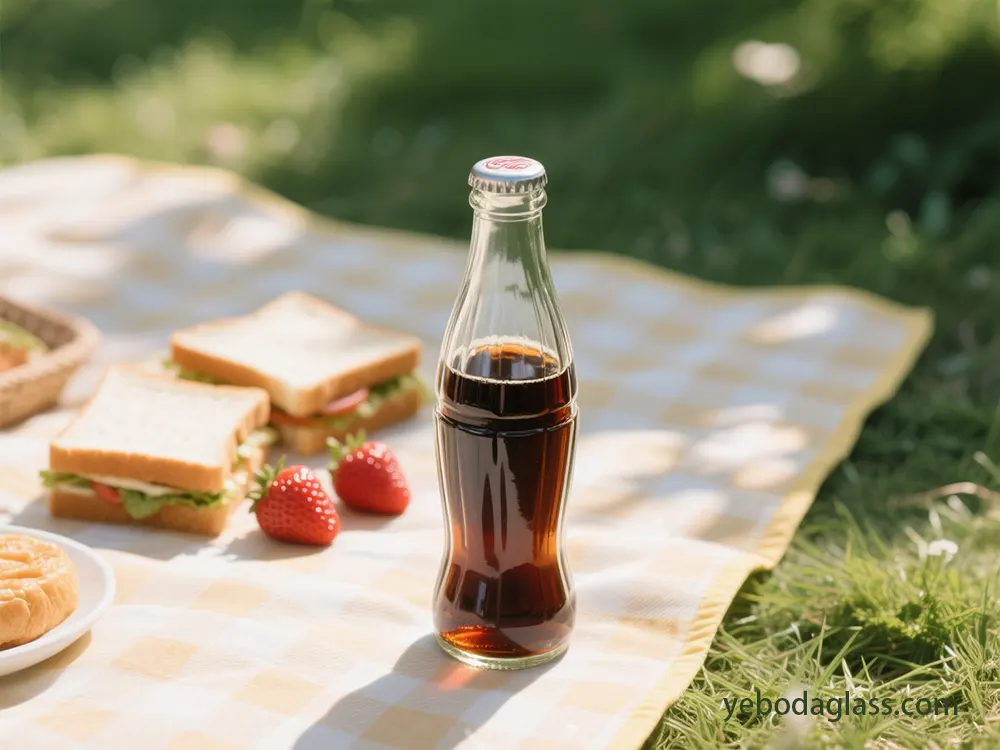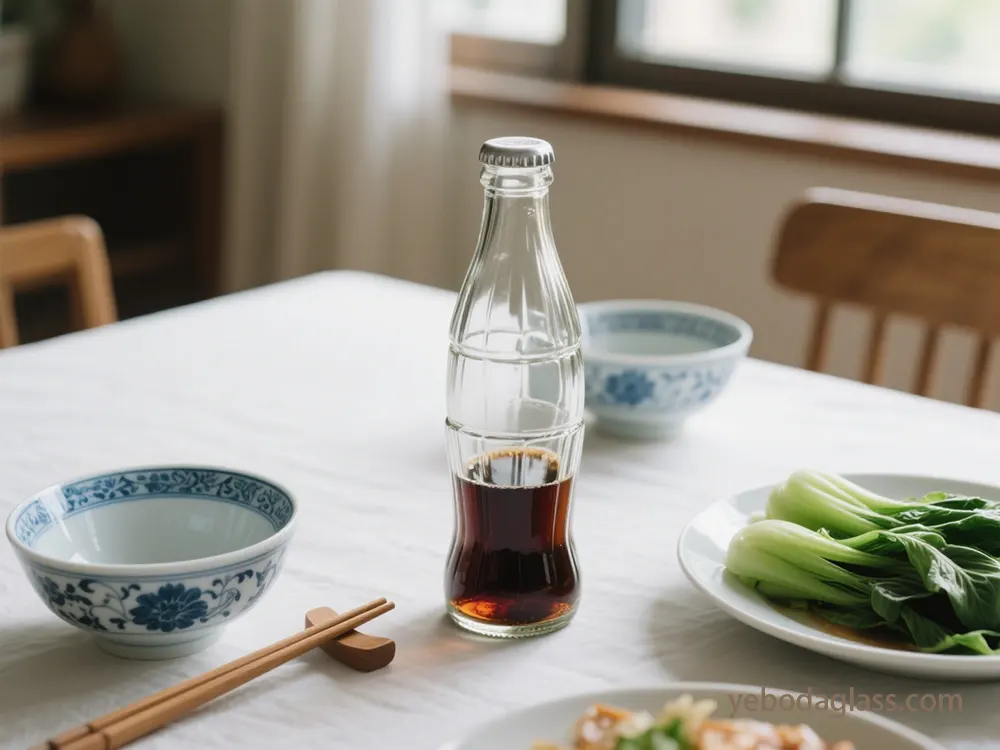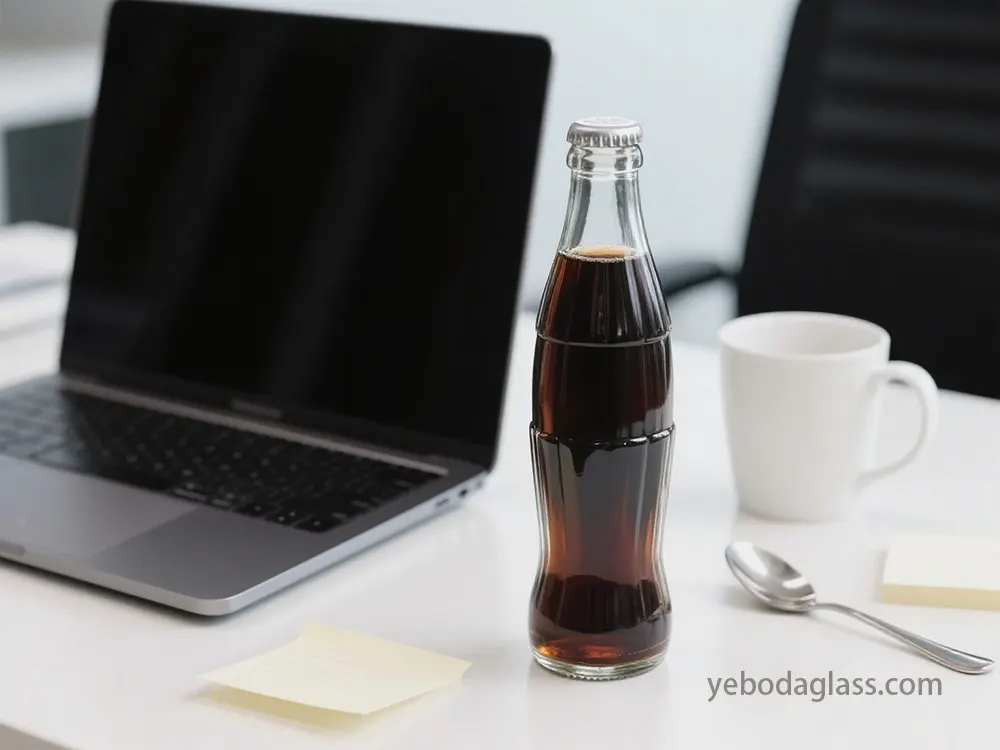PET’s lighter weight and durability allow more units per pallet, optimizing storage and transport space.This leads to better warehouse utilization compared to glass. PET bottles can also be stackable, further enhancing space optimization.
4.4. Production Costs and Material Composition
PET bottles generally have lower production costs due to more efficient manufacturing processes and typically less expensive raw materials. Glass manufacturing is energy-intensive, requiring high temperatures, contributing to higher production costs.
4.5. Damage Comparison Across Materials
PET generally offers advantages in reduced damage rates and overall logistical resilience compared to other materials like tinplate.
5. Brand Positioning and Consumer Perception
Packaging profoundly influences consumer perception and brand identity.
5.1. Premium Image and Taste Perception
Consumers associate glass with higher quality, fresher taste, and superior cold retention.Glass’s inertness preserves original taste and quality, vital for premium, organic, or “clean label” brands. Products in glass are often rated tastier.
5.2. Sustainability Perception and Brand Values

Glass is widely perceived as more sustainable due to recyclability and ocean-friendly nature.While infinitely recyclable, its recycling is more strength-in depth than PET.Consumers increasingly decide upon reusable and recyclable packaging.
5.3. Design, Aesthetics, and Differentiation
Glass gives particular layout attributes, improving premiumization, particularly for wine and spirits. Its clarity, weight, and tactile feel bring luxury.PET additionally offers excessive design flexibility, and plastic mimicking glass aesthetics is appealing.
5.4. Convenience and Practicality Trade-offs
Glass is frequently seen as much less convenient due to weight, breakage threat, and non-resealability. PET is greater sensible for mass-marketplace and on-the-pass consumption due to its lightweight and durability.
5.5. Demographic, Psychographic, and Regional Influences
Consumer possibilities range by using life-style (e.G., urban vs. Rural) and region, motivated by way of nearby conduct and policiesOlder generations may favor returnable glass.
5.6. Market Growth and Cost Considerations
The global glass packaging market is projected for significant growth.While consumers pay a premium for hygienic packaging like glass, the industry faces pressure to innovate with lighter, more cost-effective glass options to compete with PET and cans.
6. Sustainability Objectives and Regulatory Compliance
Sustainability and regulatory compliance are vital packaging issues.
6.1. Life Cycle Assessment (LCA) Comparisons
LCAs compare environmental impacts. Recent complete LCAs regularly desire PET, concluding PET plastic bottles are appreciably better for the environment than aluminum cans and glass bottles across several key metrics.
6.2. Environmental Advantages of PET
PET bottles typically produce fewer greenhouse fuel (GHG) emissions, generate much less strong waste, eat much less water, and result in fewer emissions contributing to acid rain and smog compared to glass and aluminum.Choosing PET over glass for soda for three hundred and sixty five days ought to avoid GHG emissions equivalent to putting off almost 53,000 garbage trucks of waste from landfills.
6.3. Impact of Glass Weight and Lightweighting
Glass bottle production is a major driver of life cycle impacts due to its weight.Glass bottles would need to be approximately 40% lighter to achieve comparable global warming impacts to PET.Lightweighting innovations can reduce glass’s carbon footprint.
6.4. Role of Recycled Content and Circularity
Recycled PET (R-PET) demonstrates excessive environmental sustainability, with advanced overall performance in international warming capacity and fossil gas shortage as compared to glass.PET bottles are 100% recyclable and may be made with one hundred% recycled content material. Glass is also infinitely recyclable, but its recycling is greater electricity-in depth.
6.5. Extended Producer Responsibility (EPR) Schemes
EPR schemes for packaging are expanding globally, driven by way of plastic pollution and circular financial system standards. They involve prices on producers, often modulated based on recyclability or recycled content material, incentivizing sustainable designs.
6.6. Deposit Return Systems (DRS) and Minimum Recycled Content
DRS, regularly related with EPR, increase collection costs through refunding deposits upon container go back. Many jurisdictions also mandate minimal recycled content material for beverage packaging, driving demand for recycled materials.
6.7. Regulatory Landscape and Harmonization Challenges
The EU’s Packaging and Packaging Waste Directive (PPWD) drives EPR in Europe, with ongoing revisions presenting stricter targets. National versions in EPR create complexity for manufacturers, main to divergent expenses and operational information.Similar developments are occurring in North America, with efforts to harmonize schemes globally.
6.8. Stakeholder Engagement and Economic Impacts

Effektīvi EPR shēmas prasa plašu stakeholder apvienību. Tie var izveidot darbavietas un刺激 innovation, tomēr var palielināt īss Termiņa izmaksas produktiem un patērētājiem.
7. Comparative Analysis: Glass vs. PET Packaging
Šajā daļā tiek sniegtas divpusējas glass un PET apraīzes.
7.1. Material Performance and Product Protection
Oksīda Bariera:
GlASS piedāvā augstāku, apmēram pilnvērtīgu oksīda barjeru.PET ir caurspīdīgs, pievienojot augstu barjera tehnoloģijas iekšlietām.
CO2 Ierobežošana:
GlASS sniedz lielisku CO2 ierobežošanu.PET CO2 bariera ir laba, tomēr nav pilnvērtīga, pievienojot specializētās dizainu ilgtermiņa ierobežošanai.
Inertness:
GlASS ir ķīmiski inertss, saglabājot smērību un kvalitāti.PET ir parasti stabilss un FDA apstiprināts, tomēr glASS piedāvā pilnvērtīgu inertumu ļoti感受性 formulu.
Light Protection:
Taisns glASS un PET piedāvā ierobežotu UV aizsardzību; krāsu glASS vai UV bloķētām PET ir jālieto.
Water Vapor Barrier:
GlASS piedāvā būtiski augstāku ūdensvārīšanas barjeru, salīdzinot ar PET.
7.2. Manufacturing and Production Costs
Skaudainais materiāls & Rūpniecība:
PET parasti ir zemākas rūpniecības izmaksas, dēļ efektīvas rūpniecības un mazākos sākotnējiem materiāliem.GlASS rūpniecība ir enerģijas intensīva, izraiso augstākus izmaksas.
Butiņu līniju kapitāla izdevumi (CapEx):
PET līnijas parasti piedāvā zemāku sākotnējo investīciju vienīgās apjoma ziņā.
Operāciju efektivitāte (OEE):
Hīts:
PET līnijas ir izstrādātas augstās apjoma operācijām (24,000+ BPH).GlASS līnijas darbojas lēnāk (3,000-12,000 BPH) dēļ trūkstamības.
Pārtraukumi:
GlASS līnijas saskaras augstākām pārtraukumu līmenē.PET līnijas ir ievērojami zemāka līmeņa.
Uzturēšana:
- Abas vēl ir nepieciešama rūpniega uzturēšana. Pārmaiņu laiki:
- PET līnijas piedāvā lielāku fleksibilitāti un ātrākus pārmaiņu laikus.GlASS līnijas arī var būt fleksiblas ar ātrām formātu pārmaiņu rīkiem. Plaukumu izmantošana:
- Bloķu PET mašīnas šavina rūpniecības telpu. 7.3. Logistika un Distribūcijas izmaksas
- Svars ietekmē: Glāss ir ievērojami smagāks, izraisa augstākus transporta izmaksas (līdz piecām reizēm vairāk nekā plēvi).PET var švārtot līdz 30% uz transportu.
- Paletēšana & Skūpstu noliktavas: PET viegla svars ļauj ielādēt vairāk butiņu pa paletē, optimizējot noliktavu un transporta telpu.
Saldzināšanā transportā:
- Glāss trūkumu ļaužu palielināt operāciju izmaksas un rīksus.PET ietekmju rezistence minimalizē zudumus. 7.4. Zīmes līdzsvarošana un Patiekamības izjūta
- Premium izjūta: Glāss ir stipri saistīta ar augstu kvalitāti un elegантu.PET tiek uzskatīts par praksiskāku masu tirgus.
Garšuma izjūta:- Patiekamie bieži reitē produktus glāss kā garšākus. Uzturisko izjūta:
- Glāss tiek plaši uzskatīts par uzturiskāku.PET ir arī 100% atkalrēķināms un var integrēt augstu atkārtotas sastāvdaļas satveri. Konveniens:
- PET sniedz augstāku konveniens dēļ viegla svars un izturības.Glāss ir mazāk konvenients. Dizaina izvietojums:
- Abi sniedz izvietojumu; glāss pārnest tradicionālu augstu, PET ļauj inovatīvām formām un vieglatušanai. 7.5. Pārvaldības atliekas un Regulācijas pieķeršanās
- Dzīves cikla ietekmes: Jaunākie LCA liecina, ka PET butiņas tipiski ir zemāks pārvaldības atliekas ietekmē nekā glāss visās dažādās kategorijās, kopā ar GHG izdīķšanām un ūdens izmaksām.
Atkalrēķinātā sastāvs:
- PET butiņas ir 100% atkalrēķināmas un var būt izgatavotas ar 100% atkalrēķinātu saturu (R-PET), ievērojami uzlabojot to pārvaldības atliekas profilu.Glāss ir bezgalīgi atkalrēķināma, tomēr tās atkalrēķināšana ir vairāk enerģijas intensīva. EPR un DRS:
- Abi ir challenges pieaugošajām EPR shēmām un DRS globāli, iespaidojot uzturiskus dizainus. Regulāciju sarežģījumi:
- Dažādas EPR noteikumi valstīs radīju pagriežamības izmaksām ražotājiem. 8. Stratēģiskie rekomendācijas
Optīmālās pakalpojuma apdare jūsu produktā, YEBODA, atkarīga no produktu vajadzību, tirgus dinamikas, zīmes iestāšanas un uzturisko mērķu līdzsvarošanas.
- 8.1. Recommendation for Premium, Highly Sensitive, or Niche Products If YEBODA is a premium, high-stop beverage wherein flavor purity, perceived fine, and logo background are paramount, or if it’s pretty sensitive to oxygen/requires absolute inertness, glass packaging is usually recommended.
- Rationale: Glass offers superior oxygen and CO2 barrier homes, making sure most product integrity and shelf lifestyles.Its inertness preserves original taste and exceptional, vital for a top class emblem.Consumer notion of glass as awesome and sustainable aligns with a premium identification.Higher logistics expenses can be offset by way of top class pricing. Consider lightweighting glass to mitigate affects.
- 8.2. Recommendation for Mass-Market, High-Volume, or On-the-Go Products If YEBODA objectives a broader mass marketplace, calls for excessive-extent production, emphasizes convenience, or is for on-the-cross intake, PET packaging is usually recommended.
- PET gives sizeable blessings in decrease manufacturing prices, reduced transportation charges (as much as 30% financial savings) due to light-weight nature, and advanced durability.PET strains are designed for high-velocity operations (24,000+ BPH) and provide extra layout flexibility and faster changeover instances, critical for high-extent production.While PET has higher oxygen transmission, advanced barrier technology can control this for sensitive beverages.Recent LCAs suggest PET commonly has a lower environmental footprint, especially with recycled content,aligning with sustainability dreams and EPR schemes. 8.3. Hybrid Approach or Phased Transition (Consideration)
- A hybrid approach should use glass for a top class line (e.G., hospitality) and PET for mass-marketplace or on-the-go formats. A phased transition from glass to PET may also be explored, requiring careful consumer perception control and clear communique of sustainability advantages. 8.4. Proactive Measures for Chosen Material

For Glass:
- Invest in lightweighting technology.Explore refillable structures in which feasible.Implement strong line protection to decrease breakage. For PET:
- Prioritize recycled PET (R-PET) to beautify sustainability and follow mandates.Invest in superior barrier technologies for most reliable product protection.Engage with Producer Responsibility Organizations (PROs) and adapt to evolving EPR/DRS policies. 9. Conclusion
- The decision among glass and PET for YEBODA is multifaceted. Glass excels in inertness, premium notion, and absolute barrier residences, best for excessive-cost, touchy, or background merchandise. PET gives compelling blessings in decrease production/logistics fees, higher production speeds, and a usually greater favorable environmental profile, specially with recycled content material and advanced barrier technology. The strategic recommendation hinges on number one commercial enterprise targets: prioritizing premium positioning and flavor integrity may also desire glass, while optimizing for fee-efficiency, high-extent distribution, and environmental narrative can also choose PET. A nuanced method, potentially a hybrid approach or phased transition, should leverage each substances’ strengths. Continuous monitoring of marketplace developments, patron possibilities, and regulatory developments might be important for YEBODA’s aggressive facet and sustainable growth.
- Latest Blogs Read More »
Glass Bottle Company Innovations Driving the Future of Premium Packaging
Sustainable Custom Glass bottles: Aligning Your Brand with Eco Trends
Glass Food Storage Containers: Smart Choice for Health
Contact Us
- Comment breadcrumbs
Open table of contents
Close table of contents
- Comment PET sniedz lielas priekšrocības mazākām ražošanas izmaksām, samazinātām transporta izmaksām (līdz 30% finansiāliem iekspozīcijiem) dēļ vieglās īpašības un paaugstinātas izturības. PET šķirti ir izstrādāti augstās ātrības operācijām (24 000+ BPH) un piedāvā papildu dizaina flexibilitāti un ātrākus pārslēgšanās periodus, kas ir kritiski augstās apjoma ražošanai. Kamēr PET ir augstāks skābekļa pārplūduma līmenš, attīstītā barjera tehnoloģija var kontroli šim par ātrām dzēriem. Recent LCAs liecina, ka PET bieži piedzīvo zemāku ietekmi uz vidi, īpaši ar atkārtotas izmantošanas saturu, atbilstot sustainability mērķiem un EPR shēmām.
8.3. Hibrīdains uzvedums vai Phāziskā pāreja (Uzmanība)
Hibrīdains uzvedums jāizmanto stiklu augstās klases līnijām (piemēram, gildei) un PET masu tirgus vai pārdomātās formātās. Stikla uz PET pāreja var arī tikt izpētīta, prasa precīzu patērētāju uztveres kontroles un skaidru sustainability priekšrocību informēšanu.
8.4. Proaktīvas rīkumi izvēlētajam materiālam
- Par stiklu: Invēstīt vieglāko tehnoloģiju. Atpakaļvis pārdomājamās struktūras, ja iespējams. Implementējot stipru līnijas aizsardzību, lai samazinātu šķiršanos.
- Par PET: Prioritēt atkārtotas PET (R-PET), lai paaugstinātu sustainability un sekot pavēlēm. Invēstīt augstākas barjera tehnoloģijas visu produktu aizsardzībai. Sajauties Producer Responsibility Organizations (PROs) un piemētoties evolūcijas EPR/DRS politikām.
9. Konklūzija
Izlases starp stiklu un PET YEBODA ir vairākās virzienā. Stikls izceļas neitralitātē, augstās izskatā un absolūtā barjera īpašībās, labšs augstu izmaksu, saskarību vai fona preču. PET piedāvā spēcīgas priekšrocības zemākām ražošanas/loģistikas izmaksām, augstākajām ražošanas ātrībām un parasti pozitīvākām vides profilu, īpaši ar atkārtotas izmantošanas saturu un attīstītām barjera tehnoloģijām.
Stratēģiskā ieteikums balstās uz galvenajiem uzņēmuma mērķiem: prioritējot augstāku pozīciju un garša integritāti var būt nepieciešams stikls, bet optimizējot par izmaksu-effektivitāti, augstās apjoma distribūciju un vides rādītāju var izvēlēties PET. Skaisti uzvedums, iespējams hibrīdains uzvedums vai phāziskā pāreja, jāizmanto abu materiālu spējām. Pastāvīgi novēršot tirgus izvēstījumu, patērētāju vēlmju un regulatīvo izmaiņu monitoringu būs svarīgi YEBODA konkurētspējas un sustainability attīstības ziņā.

